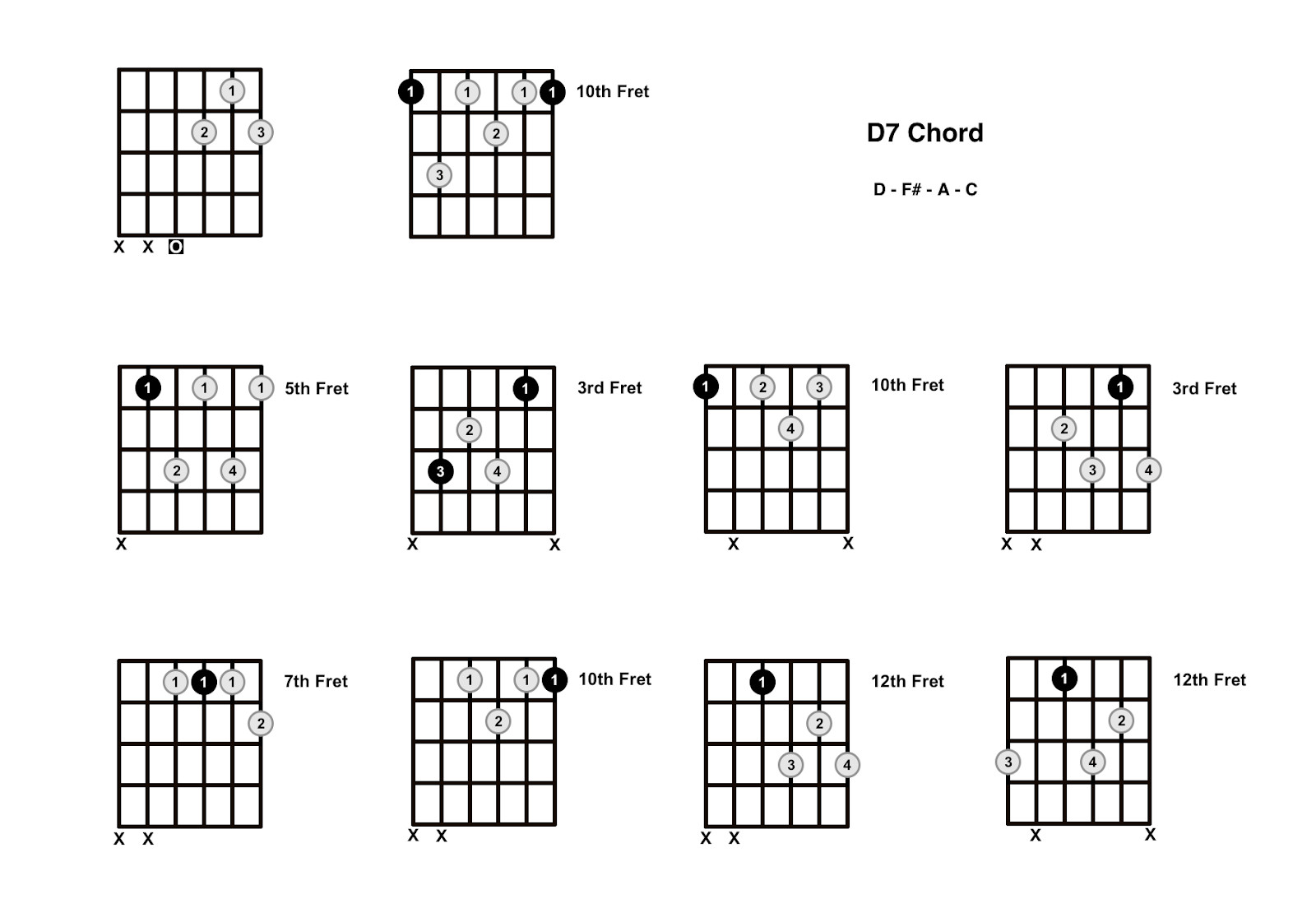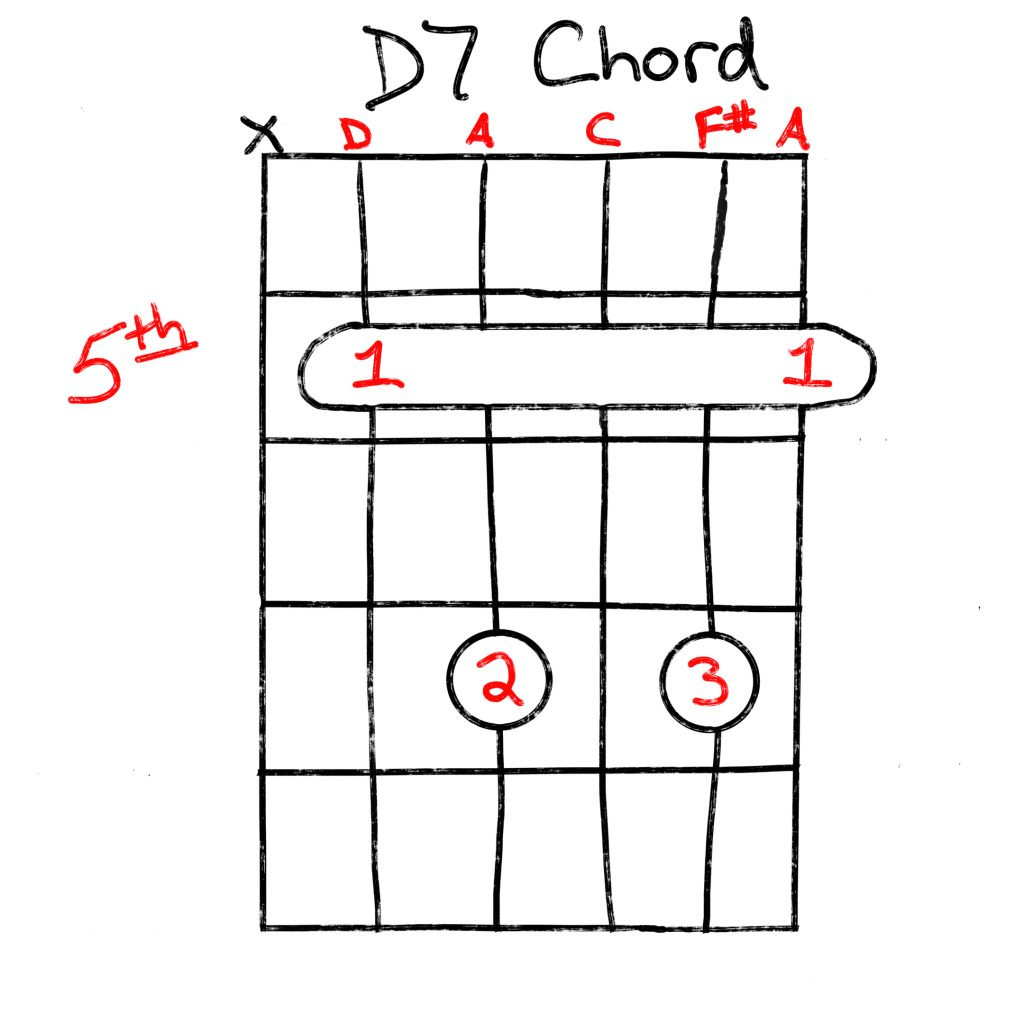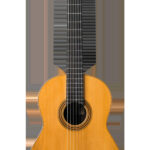The D7 guitar chord is a staple for guitarists across genres, adding a unique color and depth to your playing. If you’ve encountered the D7 chord and felt unsure how to approach it, or perhaps you’re just beginning your chord journey, you’ve landed in the right place. This guide will provide you with everything you need to know to confidently play the D7 chord and integrate it into your music.
Similar in function to the B7 chord, the D7 is known as a D dominant seventh chord. This chord is celebrated for its uplifting and slightly bluesy character, making it a favorite in country, mellow-rock, jazz, and even pop music. Its versatility makes it an essential addition to any guitarist’s chord vocabulary.
The D7 chord is more than just a variation; it’s a gateway to richer harmonies and more expressive playing. Its role in creating anticipation and smooth transitions in chord progressions is invaluable. Whether you are strumming campfire songs or exploring jazz standards, understanding and mastering the D7 chord will significantly enhance your musical toolkit.
Let’s dive into the most common and effective ways to play the D7 chord on your guitar.
How to Play the Open D7 Chord: A Step-by-Step Guide
The D7 chord is a four-note chord, constructed from the notes D, F#, A, and C. These notes comprise the root (D), the major third (F#), the perfect fifth (A), and the flat seventh (C) of the D major scale.
To form the open D7 chord, follow these finger placements on the fretboard:
 D7 Chord On The Guitar (D Dominant 7) – Diagrams, Finger …
D7 Chord On The Guitar (D Dominant 7) – Diagrams, Finger …
- Index Finger (1st Finger): Place your index finger on the 2nd fret of the G string (3rd string).
- Middle Finger (2nd Finger): Position your middle finger on the 2nd fret of the high E string (1st string).
- Ring Finger (3rd Finger): Place your ring finger on the 3rd fret of the B string (2nd string).
Once your fingers are correctly positioned, strum all strings except the low E string (6th string). Avoiding the low E string is crucial for achieving the characteristic sound of the D7 chord in this open position.
This open D7 chord is often considered the easiest variation to learn, especially if you are already familiar with the D major chord. In fact, the finger positioning is quite similar to the D major chord, making the transition relatively smooth.
Exploring Variations of the D7 Chord
While the open D7 chord is a great starting point, there are other ways to play the D7 chord on the guitar, offering different voicings and possibilities. Here are a couple of common variations:
D7 Chord with Open A String
This variation is essentially the same as the open D7 chord described above. The description “with Open A String” is more about emphasizing which strings to strum (from the A string downwards) rather than a different fingering. You still use the same finger placements as the standard open D7 chord:
- Index Finger: 2nd fret of the G string.
- Middle Finger: 2nd fret of the high E string.
- Ring Finger: 3rd fret of the B string.
Strum from the open A string down to the high E string.
Barre D7 Chord
For a different voicing and to play the D7 chord in different positions on the neck, the barre D7 chord is a valuable technique to learn. This variation is movable, allowing you to play a 7th chord with any root note.
 Barre D7 Chord Diagram
Barre D7 Chord Diagram
- Barre with Index Finger: Barre your index finger across all six strings at the 5th fret.
- Middle Finger: Place your middle finger on the 6th fret of the G string (3rd string).
- Ring Finger: Place your ring finger on the 7th fret of the B string (2nd string).
- Pinky Finger: Place your pinky finger on the 7th fret of the high E string (1st string).
Strum all six strings for this barre chord variation. This form of D7 is useful when you need a D7 chord higher up the neck or when transitioning from other barre chords.
Popular Songs Featuring the D7 Chord
The D7 chord’s distinctive sound makes it a favorite in many well-known songs across various genres. Learning songs that use the D7 chord is a fantastic way to practice and hear the chord in context. Here are a few examples:
-
“Can’t Help Falling in Love” – Elvis Presley: This timeless classic from 1961 prominently features the D7 chord in its chorus progression. The gentle ukulele-like strumming in the original version beautifully showcases the soft, romantic side of the D7 chord. Practicing this song will help you understand how D7 can create a sweet and tender atmosphere.
-
“Ain’t No Sunshine” – Bill Withers: Released in 1971, this soulful hit is built around a repeating chord progression that includes the D7 chord. “Ain’t No Sunshine” is an excellent song for practicing transitions to and from the D7 chord, as it’s a central part of the song’s harmonic structure. The song’s melancholic mood highlights the slightly bluesy and yearning quality of the D7.
-
“Brown Eyed Girl” – Van Morrison: This upbeat and feel-good song from 1967, a top 10 hit on the Billboard charts, makes significant use of the D7 chord, contributing to its cheerful and nostalgic vibe. “Brown Eyed Girl” is great for practicing strumming patterns with the D7 chord in a major key context, demonstrating how D7 can also be used in happier, more energetic songs.
Understanding the Role of the D7 Chord in Chord Progressions
The D7 chord is not just a standalone chord; it plays a crucial role in chord progressions, particularly as a dominant chord. In the key of G major, the D7 chord functions as the V7 chord (dominant 7th), creating a strong pull towards the G major chord (the tonic or I chord).
This dominant function means the D7 chord naturally creates tension and anticipation, which is then resolved when you move to the G chord. This V7-I progression (D7-G) is one of the most fundamental and satisfying chord movements in Western music and is used extensively across genres.
You can also use D7 to lead to a G minor chord, creating a bluesier or more modal sound. Experimenting with D7 in different keys and progressions will deepen your understanding of harmony and chord relationships.
Tips for Mastering the D7 Chord
- Start with the Open D7: Focus on getting the open D7 chord clean and comfortable first. Practice transitioning to and from D7 from other common chords like G, A, or D major.
- Ensure Finger Accuracy: Make sure your fingers are pressing down firmly just behind the frets to get a clear sound without buzzing.
- Listen for Clarity: Strum the chord slowly and listen to each string to ensure every note rings out clearly. Adjust your finger positions if any strings are muted or buzzing.
- Practice Chord Changes: Use chord练习 apps or backing tracks in the key of G to practice changing to and from the D7 chord in a musical context.
- Explore Songs: Learn songs that feature the D7 chord to make practice more engaging and to hear how the chord is used in real musical situations.
Conclusion: Embrace the Versatility of the D7 Chord
The D7 guitar chord is a powerful and versatile tool for any guitarist. From its warm, inviting sound in ballads to its bluesy edge in rock and jazz, the D7 chord adds a unique dimension to your playing. By mastering the fingerings, understanding its role in chord progressions, and practicing with songs, you’ll unlock a new level of musical expression. So, pick up your guitar, practice your D7 chord, and start exploring the rich possibilities it offers!

